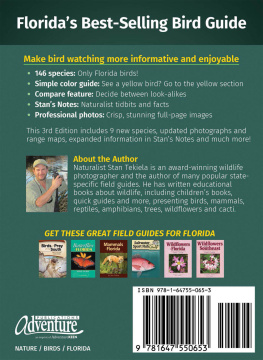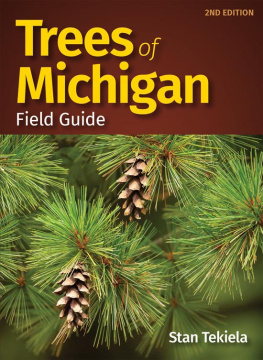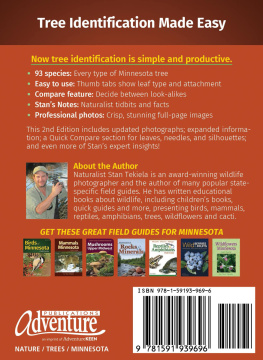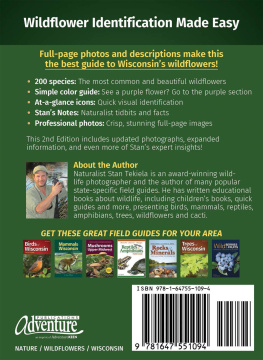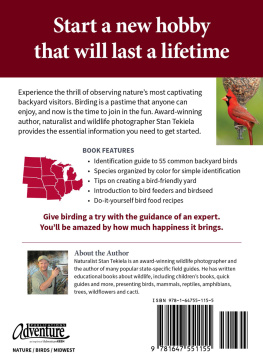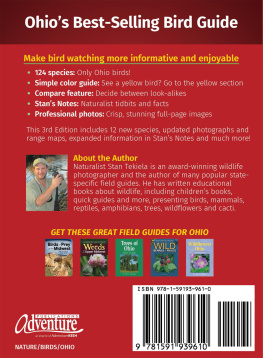
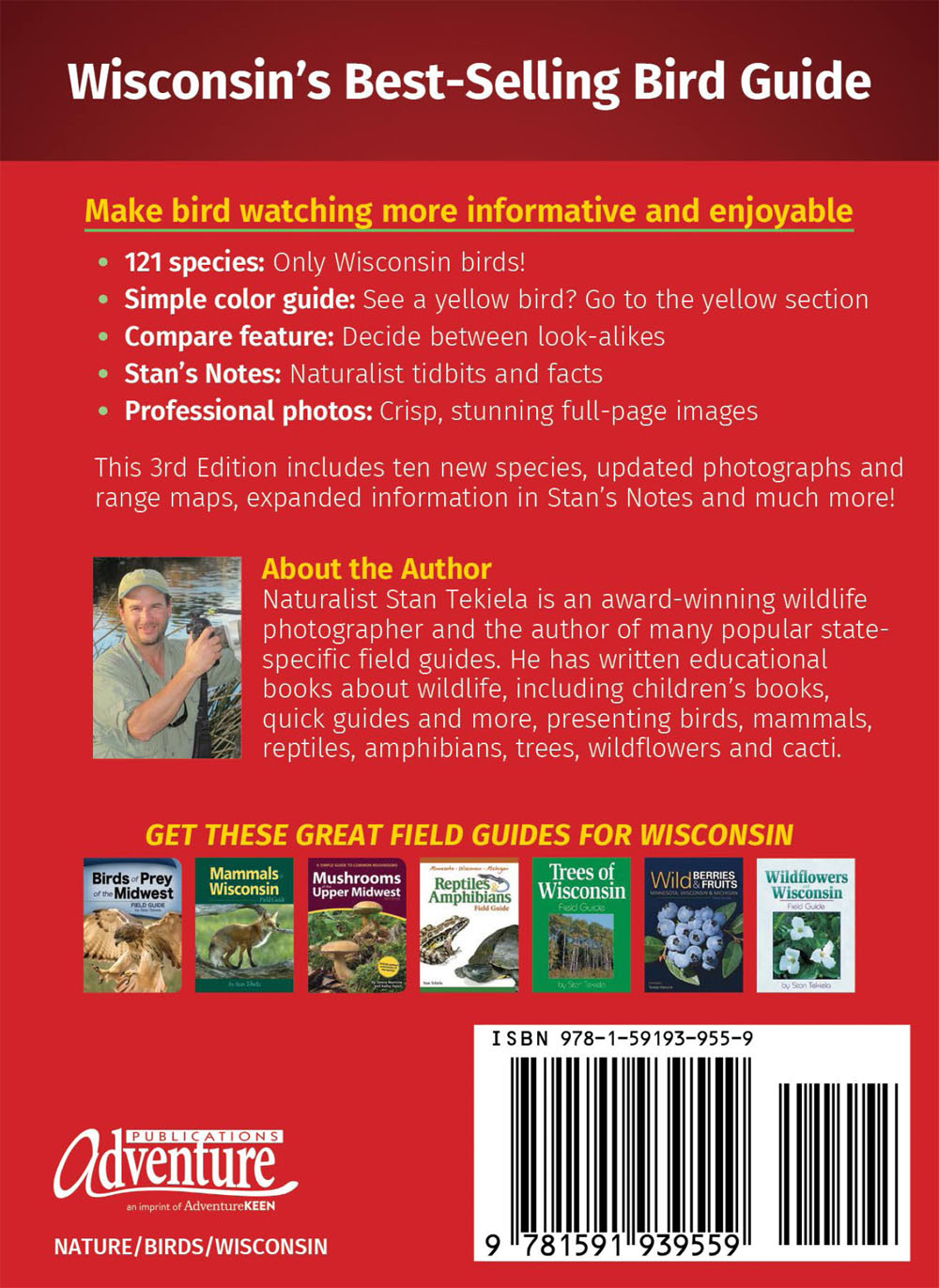

Edited by Sandy Livoti and Brett Ortler
Cover, book design and illustrations by Jonathan Norberg
Range maps produced by Anthony Hertzel
Cover photo: American Robin by Stan Tekiela
All photos by Stan Tekiela except (female) by Jim Zipp
To the best of the publishers knowledge, all photos were of live birds. Some were photographed in a controlled condition.
10 9 8 7 6 5 4 3 2 1
Birds of Wisconsin Field Guide
First Edition 1999
Second Edition 2004
Third Edition 2020
Copyright 1999, 2004 and 2020 by Stan Tekiela
Published by Adventure Publications
An imprint of AdventureKEEN
330 Garfield Street South
Cambridge, Minnesota 55008
(800) 678-7006
www.adventurepublications.net
All rights reserved
Printed in China
ISBN 978-1-59193-955-9 (pbk.); ISBN 978-1-59193-956-6 (ebook)
Dedication
To my wife, Katherine, and daughter, Abigail, with all my love.
Acknowledgments
Special thanks to the National Wildlife Refuge System, which stewards the land that is critical to many bird species.
TABLE OF CONTENTS
WHATS NEW?
It is hard to believe that its been more than 20 years since the debut of Birds of Wisconsin Field Guide. This critically acclaimed field guide has helped countless people identify and enjoy the birds that we love. Now, in this expanded third edition, Birds of Wisconsin Field Guide has many new and exciting changes and a fresh look, while retaining the same easy-to-use, familiar format.
To help you identify even more birds in Wisconsin, I have added 10 new species and am featuring 131 new color photographs. All of the range maps have been meticulously reviewed, and many updates have been made to reflect the ever-changing movements of the birds.
Everyones favorite section, Stans Notes, has been expanded to include even more natural history information. Compare sections have been updated to help ensure that you correctly identify your bird, and additional feeder information has been added to help with bird feeding. I hope you will enjoy this great new edition as you continue to learn about and appreciate our Wisconsin birds!

WHY WATCH BIRDS IN WISCONSIN?
Millions of people in Wisconsin have discovered bird feeding. Setting out feeders is a simple and enjoyable way to bring birds and their beauty closer to you. Watching birds at your feeders and listening to them often leads to a lifetime pursuit of bird identification. Birds of Wisconsin Field Guide is for those who want to identify the common birds of Wisconsin.
More than 1,100 species of birds are found in North America. In Wisconsin, upwards of 400 species of birds were documented throughout the years. These bird sightings were diligently recorded by hundreds of bird watchers and became part of the official state records. From these, I have chosen 121 of the most common birds of Wisconsin to include in this field guide.
Bird watching, also called birding, is one of the most popular activities in America. Its outstanding appeal in Wisconsin is due to unusually rich and abundant birdlife all around the state.
At more than 65,400 square miles (170,000 sq. km), Wisconsin is the twenty-third largest state. Despite its large size, only about 6 million people call Wisconsin their home. On average, that is only 105 people per square mile (40 per sq. km). Most live in or around five major cities in the lower one-half of the state, which leaves plenty of room for a wide variety of birds to roam.
Several distinct habitats in Wisconsin support different groups of birds. Upper northern Wisconsin is covered with vast stands of evergreen (coniferous) forests, nearly 8,000 lakes and thousands of miles of streams and rivers. The evergreen woods are havens for Common Ravens, Evening Grosbeaks, Ruby-crowned Kinglets and other birds, while Common Loons and Hooded Mergansers dive for fish in the crystal-clear northern lakes.
North of the great forests is the granddaddy of all lakesLake Superior, the worlds largest freshwater lake. Lake Michigan is on the eastern border of the state. Wisconsin has over 1,000 miles (1,609 km) of Great Lakes shoreline. The clear, cold waters and rocky shores are home to an entirely different group of birds, including Herring Gulls, Ring-billed Gulls and Common Terns.
A vegetation tension zone divides the northern coniferous forests from the southern deciduous woods. The division line runs from the western counties of Polk and Burnett, near the area of Minnesotas Twin Cities, south and to the east, ending in Milwaukee County just north of Racine. South of the tension zone is a very different forest type, which attracts different birds. Birds such as Ring-necked Pheasants, Wild Turkeys and Eastern Screech-Owls live here in the oak, maple and elm woods.
The mighty Mississippi River and the St. Croix make up most of Wisconsins western border. Several other major rivers flow across the state, each lined with tall shade-producing trees. The river valleys are outstanding places for birds. Belted Kingfishers and Green Herons fish in the shallow backwaters there.
Besides the varying habitat, Wisconsin is known for its weather. From the frigid winters to the steamy summers, there are birds to watch in every season. Whether witnessing a migration of hawks in autumn or welcoming back hummingbirds in spring, there is variety and excitement in birding as each season turns to the next.
OBSERVATION STRATEGIES: TIPS TO IDENTIFY BIRDS
Identifying birds isnt as difficult as you might think. By simply following a few basic strategies, you can increase your chances of successfully identifying most birds that you see! One of the first and easiest things to do when you see a new bird is to note its color. This field guide is organized by color, so simply turn to the right color section to find it.
Next, note the size of the bird. A strategy to quickly estimate size is to compare different birds. Pick a small, a medium and a large bird. Select an American Robin as the medium bird. Measured from bill tip to tail tip, a robin is 10 inches (25 cm).
Now select two other birds, one smaller and one larger. Good choices are a House Sparrow, at about 6 inches (15 cm), and an American Crow, around 18 inches (45 cm). When you see a species you dont know, you can now quickly ask yourself, Is it larger than a sparrow but smaller than a robin? When you look in your field guide to identify your bird, you would check the species that are roughly 610 inches (1525 cm). This will help to narrow your choices.
Next, note the size, shape and color of the bill. Is it long, short, thick, thin, pointed, blunt, curved or straight? Seed-eating birds, such as Northern Cardinals, have bills that are thick and strong enough to crack even the toughest seeds. Birds that sip nectar, such as Ruby-throated Hummingbirds, need long, thin bills to reach deep into flowers. Hawks and owls tear their prey with very sharp, curving bills. Sometimes, just noting the bill shape can help you decide whether the bird is a woodpecker, sparrow, grosbeak, blackbird or bird of prey.
Next page


